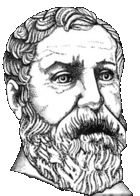

It is not known exactly when Heron lived, but in one of his works he referred to a recent eclipse which is now thought to have occurred in 62 AD.
From Heron's writings it is reasonable to deduce that he taught at the Museum in Alexandria. His works look like lecture notes from courses he must have
given there on mathematics, physics, pneumatics, and mechanics. Some are clearly textbooks while others are perhaps drafts of lecture notes not yet worked
into final form for a student textbook.
A large number of works by Heron have survived, although the authorship of some is disputed due to the frequency of the name Heron at the time. The works fall into several categories: technical works, mechanical works and mathematical works.
One of his books contains a chapter on astronomy, giving a method to find the distance between Alexandria and Rome using the difference between local times at which an eclipse of the moon is observed at each city. Another describes a puppet theater worked by strings, drums and weights. Another one describes how to construct engines of war. Yet another deals with light and mirrors, stating that vision results from light rays emitted by the eyes, and that these rays travel with infinite velocity.
His treatise Metrica contains 3 volumes. Book 1 deals with areas of triangles, quadrilaterals, regular polygons of between 3 and 12 sides, surfaces of cones, cylinders, prisms, pyramids, spheres, etc. A method, known to the Babylonians 2000 years before, is also given for approximating the square root of a number. Heron also proves the formula now known as Heron's formula: If A is the area of a triangle with sides a, b and c and s = (a+b+c)/2 then A2 = s(s–a)(s–b)(s–c). In Book 2, Heron considers the measurement of volumes of various three dimensional figures such as spheres, cylinders, cones, prisms, pyramids, etc.
Book 3 deals with dividing areas and volumes according to a given ratio, and a method for finding the cube root of a number.
The Pneumatica studies mechanical devices worked by air, steam or water pressure. Heron begins with a theoretical consideration of pressure in fluids. Some of this theory is right but, not surprisingly, some is quite wrong. There follows a description of various mechanical toys for children. It would appear that Heron used these toys as a vehicle for teaching physics to his students. It concludes with descriptions of over 100 machines such as a fire engine, a wind organ, a coin-operated machine, and a steam-powered engine called an aeolipile.
Heron wrote a number of important treatises on mechanics. They give methods of lifting heavy weights and describe simple mechanical machines. In particular
the Mechanica is based quite closely on ideas due to Archimedes. Book 1 examines how to construct three dimensional shapes in a given proportion to a
given shape. It also examines the theory of motion, certain statics problems, and the theory of the balance. In Book 2, Heron discusses lifting heavy objects with a lever, a pulley, a wedge, or a screw. There is a discussion on centres of gravity of plane figures. Book 3 examines methods of transporting objects by such means as sledges, the use of cranes, and looks at wine presses.
Some scholars consider Heron to be an ignorant artisan who copied the contents of his books without understanding what he wrote. Others approve of Heron's practical skills as a surveyor but claim that his knowledge of science was negligible. Still others see him as a well-educated and often ingenious applied mathematician.